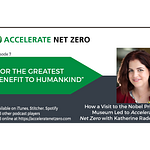How do you convince medium-sized companies to convert their fossil-fueled industrial processes to renewable energy? And how do you do that if the amount of emissions saved seems tiny compared to the…
Listen to this episode with a 7-day free trial
Subscribe to Accelerate Net Zero to listen to this post and get 7 days of free access to the full post archives.











